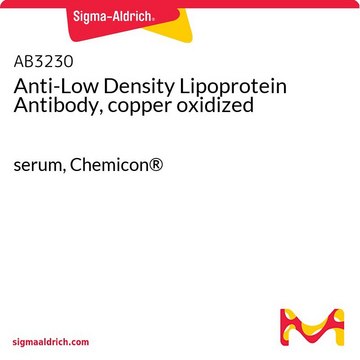MABS2278
Anti-Oxidized phospholipid Antibody, clone EO6
Synonim(y):
OX-Fosfolipid, Ox-PC
About This Item
Polecane produkty
pochodzenie biologiczne
mouse
Poziom jakości
forma przeciwciała
purified antibody
rodzaj przeciwciała
primary antibodies
klon
E06, monoclonal
masa cząsteczkowa
calculated mol wt N/A kDa
observed mol wt ~200 kDa
oczyszczone przez
affinity chromatography
reaktywność gatunkowa
all
opakowanie
antibody small pack of 100
metody
ELISA: suitable
immunohistochemistry: suitable
radioimmunoassay: suitable
western blot: suitable
izotyp
IgMκ
sekwencja epitopowa
Unknown
numer dostępu Protein ID
numer dostępu UniProt
temp. przechowywania
-10 to -25°C
Specyficzność
Immunogen
Zastosowanie
Ocena metodą ELISA z utlenioną fosfatydylocholiną-BSA (OxPC-BSA)
Analiza ELISA: Seryjne rozcieńczenie tego przeciwciała wykryło Oxidized-Phosphatidylcholine-BSA.
Testowane aplikacje
Analiza Western Blotting: Reprezentatywna partia wykryła OxPL w zastosowaniach Western Blotting (Horkko, S., et al. (1999). J Clin Invest. 103(1):117-28; Leibundgut, G., et al. (2013). J Lipid Res. 54(10)2815-30).
Analiza ELISA: Reprezentatywna partia wykryła OxPL w zastosowaniach ELISA (Horkko, S., et al. (1999). J Clin Invest. 103(1):117-28).
Zastosowania immunohistochemiczne: Reprezentatywna partia wykryła utleniony fosfolipid w zastosowaniach immunohistochemicznych (Yu, P., et al. (2018). Arterioscler Thromb Vasc Biol. 38(1):26-39).
Test radioimmunologiczny: Reprezentatywna partia wykryła OxPL w zastosowaniach testu radioimmunologicznego (Horkko, S., et al. (1999). J Clin Invest. 103(1):117-28).
Uwaga: Rzeczywiste optymalne rozcieńczenia robocze muszą być określone przez użytkownika końcowego jako próbki, a warunki eksperymentalne mogą się różnić w zależności od użytkownika końcowego.
Opis wartości docelowych
Postać fizyczna
Rekonstytucja
Przechowywanie i stabilność
Inne uwagi
Oświadczenie o zrzeczeniu się odpowiedzialności
Nie możesz znaleźć właściwego produktu?
Wypróbuj nasz Narzędzie selektora produktów.
Kod klasy składowania
12 - Non Combustible Liquids
Klasa zagrożenia wodnego (WGK)
WGK 2
Temperatura zapłonu (°F)
Not applicable
Temperatura zapłonu (°C)
Not applicable
Certyfikaty analizy (CoA)
Poszukaj Certyfikaty analizy (CoA), wpisując numer partii/serii produktów. Numery serii i partii można znaleźć na etykiecie produktu po słowach „seria” lub „partia”.
Masz już ten produkt?
Dokumenty związane z niedawno zakupionymi produktami zostały zamieszczone w Bibliotece dokumentów.
Nasz zespół naukowców ma doświadczenie we wszystkich obszarach badań, w tym w naukach przyrodniczych, materiałoznawstwie, syntezie chemicznej, chromatografii, analityce i wielu innych dziedzinach.
Skontaktuj się z zespołem ds. pomocy technicznej








